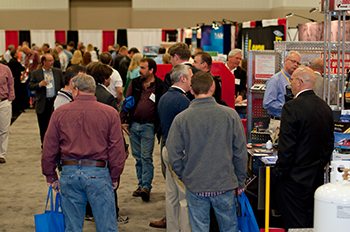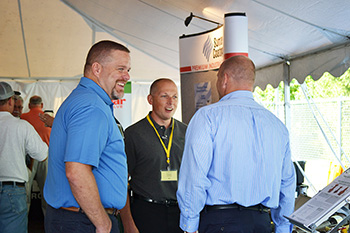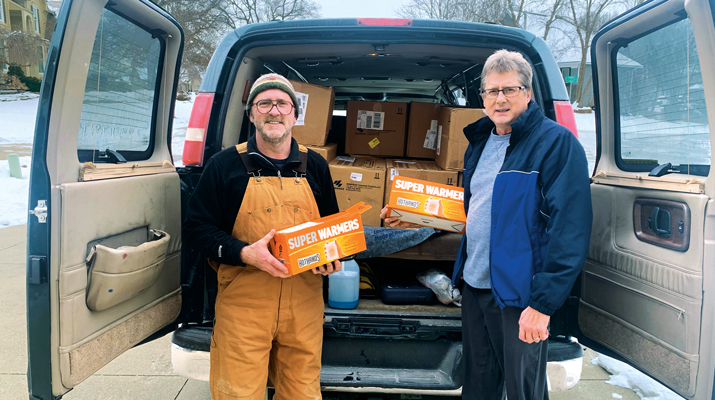Trade show roles changing in modern business landscape
Handshakes are out and thank-you emails are in.
As the world quickly digitizes, more business is taking place online and in newer forms. Fewer transactions, meanwhile, are being made in person.
The shift in where business takes place has an impact on a number of levels, but perhaps none more so than trade shows and other in-person events. The propane industry’s shows, many of which have experienced declines in attendance over the last few years, aren’t immune to the changes. The shift has forced a number of organizers to revisit their show’s value proposition and strategize new ways to attract attendees and exhibitors.
“When I first started in the industry 20 years ago and up until about 15 years ago, people went to the Southeastern [Convention & International Propane Expo] in Atlanta to buy their trucks; to buy their transports; to buy their large purchases,” says Milt Swenson, the division manager at Arrow Tank & Engineering Co., who’s also chairman of the National Propane Gas Association (NPGA) Conventions Committee. “Guys like me were taking orders for 100 or 200 trucks per year at the show.”
The Southeast show’s role has changed, though. Buying new equipment isn’t the priority it once was on the floor for marketers. Now, the show floor is where networking takes place and longtime friends revisit.
“When my dad was in the business in the 1950s, 60s, 70s and 80s, marketers would spend $1 million over a bottle of scotch and a handshake,” says David Lowe, chairman of the Midwest Propane Gas Convention. “Now, so many people do business with email, or they have an attorney look an agreement over.”
Marketers today are vastly different than the ones of even 20 years ago, Lowe adds. The perceived need to spend money to attend a trade show is not the same one marketers have always had.
Of course, as a trade show chairman, Lowe and other event organizers emphasize areas such as networking, education and extended show hours to draw attendees and exhibitors. But even then, marketers only have so many dollars to spend. So they’ve become more selective in which events they attend and who goes on behalf of the company.
These last few winters have forced marketers to be even more selective.
“If it’s a long, hard, cold winter, there’s going to be money for these shows,” says Greg Noll, executive vice president of the Propane Marketers Association of Kansas, which supports the Mid-States Propane Expo and Tabletop Trade Show. “If it’s a mild winter and expenses have to be looked at closely, trade shows may be one of the places that managers have to decide who’s getting sent and how many are getting sent.”
Retooling Southeast
One show considerably fewer marketers have attended over the last three years is the Southeastern Convention & International Propane Expo. The show’s highest attendance over the last five years occurred in 2009, with 1,431 attendees. Southeast experienced slight drops in attendance over the next two years, but the most significant drop happened last year when 15 percent fewer people attended.
NPGA formed a joint task force that met last June to discuss Southeast’s future and identify initiatives that can increase the show’s value to potential attendees. The task force, which is made up of 17 members and led by Swenson, didn’t make any swift decisions in its June meeting because no immediate changes can be made anyway due to contractual obligations with the Georgia World Congress Center and Atlanta hotels through 2014.
So rather than make final decisions three years too early, the joint task force floor was instead opened for discussion on ways to improve Southeast’s marketing, content and venue for 2015 and beyond.
“In this particular meeting, there was a lot of discussion about the venue, the hotel situation and the geographical location,” Swenson says. “We discussed both staying in Atlanta but changing the venue, as well as moving the show to different cities – primarily in the Southeast because it does seem to be a natural draw there.”
The task force also discussed changing the show’s timeframe.
“Rather than run Sunday, Monday, Tuesday, do we change to a different time of the week?” Swenson asks. “Middle of the week? End of the week? We discussed positives and negatives of doing something like that.”
In addition, surveys were distributed to gather more information from marketers who both attended and did not attend the show.
“The guys who didn’t come are the ones we need to learn more about,” Swenson says. “A lot of them talked about the economy. Some say they don’t want to keep spending $5,000 each year to see the same people they’ve seen for 10 years.”
Another area of potential discussion is show management. Jennifer Tomb, former director of conventions and meetings, and Erin Carraghan, former meetings manager, are no longer with NPGA to handle the event internally. A show management company continues to plan and organize Southeast – and now, in Tomb’s and Carraghan’s absence, the joint task force – but the conventions committee may look for additional help in the future.
“The conventions committee is made up of a bunch of marketers and suppliers to the industry,” Swenson says. “We’re not show people. So I think at some point it doesn’t hurt to ask for some experts to say if what we’re doing is right or wrong.”
Revamping Midwest

Midwest Propane Gas Convention officials are exploring new destinations for their event beyond March.
The Southeastern Convention & International Propane Expo isn’t the only show being re-evaluated. The state associations behind the Midwest Propane Gas Convention are discussing ways to boost attendee and exhibitor counts that slumped to about 300 each last year.
Just five years ago, Midwest drew 812 attendees and 442 exhibitors. Those figures slipped the following year and took a plunge in 2012 when attendance declined 34 percent and the ratio of attendees to exhibitors was nearly one-to-one.
One reason for the 2012 show’s decline was the absence of the Illinois and Indiana associations, which partnered with the Midwest Petroleum and Convenience Trade Show. But there are other reasons the show has struggled to draw in recent years.
“In the 1990s, we found it was not unusual for people to bring nine or 10 employees,” Lowe says. “Now they bring two or three. People have passed away, they’ve retired or they don’t have as much interest.”
Considering these factors, Midwest is making changes beyond 2013 and pondering new possibilities. The show will move out of Indianapolis after 2013, and a decision will be made later this year as to where the event will be hosted beyond 2013.
Another decision that will be made at some point is whether to host the show every year or put it on an every-other-year rotation with an event such as the Northeast Propane Show or the North Central Propane Industry Conference and Trade Show.
Midwest has made a scheduling change in the meantime.
“People value their weekends much more today,” Lowe says. “They’re telling us this, so one thing we’re doing for 2013 is moving the show to Tuesday through Thursday. We’ve heard this for a couple of years, and we were finally able to get a date in the planning process because you’re always one or two years out in the planning process.”
The show has also focused on enhancing its programming and surrounding events.
“Something new we’ve never done is have a tri-state breakfast,” Lowe says. “This will be near the end of the convention. All three states’ attendees [Kentucky, Michigan, Ohio] will get together and share some ideas over a breakfast.”
To the West
The Western Propane Trade Show & Convention, unlike many other industry shows, has not seen a significant decline in attendance. The show is only about half the size of Southeast, but Western Propane Gas Association President and CEO Lesley Garland says location is key for the Reno, Nev., event because it continues to draw attendees west of the Mississippi River who do not typically travel to Atlanta.
“We’ve had sellouts of our trade show floor,” Garland says. “We’ve even had waiting lists. We’ve been very pleased that we’ve been able to retain some of our longtime exhibitors and attract new companies that want to reach out to the propane companies with their goods and services.”
The Western show will remain at the Reno Events Center through 2015 because the association has been offered generous contracts from its existing hotel and show partners.
“Reno has made the most financial and logistical sense for us,” Garland says. “But we always want to make sure we are providing the best value for our attendees and exhibitors, whether that means staying in Reno or looking at another area that offers good contractual benefits.”
Trying new models
While the Western show is arguably the most unaffected of the industry’s shows by the changing industry, the weather and other factors, some smaller regional shows have felt many of the same effects as the larger ones. So in anticipation of further consolidation and the possibility of another mild winter, shows like the Mid-States Propane Expo and Tabletop Trade Show are contemplating changes.
“We need to get a higher number of drivers, office personnel, etc.,” Noll says of Mid-States. “We are seeing a smaller industry through acquisitions, mergers and closures. We lose people through attrition.
“We could have the best seminars and the best educational opportunities in the country, but if you don’t have butts in the seats, then you’re not successful.”

Distributors like Bergquist have found their annual open houses to be a unique opportunity to create additional connections between marketers and manufacturers.
Other events that have found a niche in the industry over the years are the annual open houses for distributors Bergquist and Ray Murray Inc. Bergquist has hosted its open houses in Bowling Green, Ky., and Toledo, Ohio, for seven years. It originally started the open houses to give marketers in the region a more cost-effective way to meet with manufacturers.
“The tabletop shows have grown in interest and popularity every year,” says Don Montroy, Bergquist’s marketing director. “This past year we had a presentation by PERC, and that’s something we want to continue to do if PERC is willing. It’s also interesting for our customers to see our warehouse and understand how we do business. They can’t really get that from our trade shows.”
The Ray Murray Open House, meanwhile, had its second-largest event in 2012. According to Ray Murray, the event has typically drawn anywhere between 650 and 800 people over the last five years. Between 900 and 1,000 people attended in 2012.
“We try to target some things toward owner-managers and other things toward technicians,” Murray says. “We try to get a diverse group of people interested in attending.”
As successful as the one-day open houses have been, Montroy and Murray say open houses and trade shows have a place in the industry.
“You really have to have both,” Murray says. “We do get a different sort of crowd at the Southeast convention than at our open house. You have to be at both events because you’re looking at different people.”
Photos: LP Gas
















